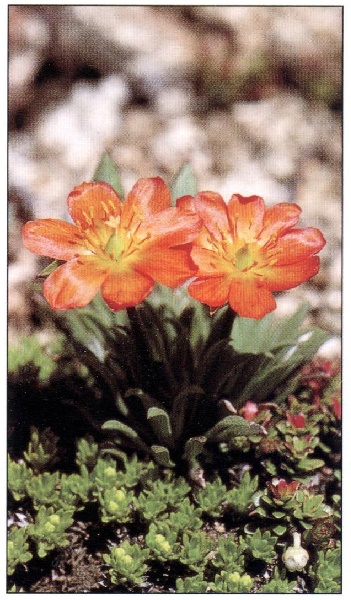Authors:
Extremely variable, the thick fleshy taproot producing at one extreme a solitary or few rather lax rosettes with quite flaccid tufted leaves up to 3.5cm, and small miserable non-opening flowers of milky-blush, on more or less prostrate stems. At the other extreme the crown may ramify into a number of branched caudices, forming a solid cushion of tight, firm rosettes, distinct and flattened, with leaves of only 5mm in length, producing showy, wide open starry flowers, 1-1.5cm across, glistening red with a large greenish-golden centre, on radiating to suberect stems. Whatever the variability, certain characteristics such as overall glabrousness, remain constant. The leaves are narrowish and acute, linear-oblanceolate to subspathulate in outline, with a prolonged taper at the base. The peduncle is two to three times longer than the leaves unlike all others in its section. Sepals are somewhat triangular-ovate and pointed-tipped. Petals five to eight and stamens seven to fifteen. As well as the two variations described, there is a third from the middle of the range, similar in general appearance to the red-flowered plant, but with much larger, notched, golden-orange petals which overlap. The seeds of this are twice as large as the others. It has been distributed as 'C. portulacoides\\ an unpublished and unrecorded name. There seems to be no intergrading between these three distinctive plants and if this is indeed so it seems highly unsatisfactory that there is no currently accepted taxonomic division at any level. The red-flowered form has previously been recognised as C. rupestris and C. skottsbergii in various combinations, or simply as C. caespitosa var. caespitosa; the pink likewise as C. fuegiana, Chile and Argentina, from the northern desert cordilleras to the tip of Tierra del Fuego. Flowering November-March in the wild. The pink plant dominates the southern sector of this vast distribudon, usually at low altitudes from sea level to 1000m, preferring unstable saturated muds and river sands. The yellow-orange one grows in the Argentinian lake district only, at 2000m, on unstable exposed screes and associated low outcrops. The red plant lives near the upper limit of vegetation in semi-stable situations, screes, solifluctions and periglacial conditions, at 2500-4000m. Each cordex of its cushion extends continually upwards, but is usually constantly infilled by debris and soil movement, a factor to be borne in mind in its cultivation. The species does not die back and 'bake' after flowering but is winter dormant. Not difficult in cultivation and sets seed fairly readily. [Pl.70].

Sign up for our newsletter to receive our monthly update direct to your inbox. Featuring our latest articles and news.
Built by Atomic Smash

